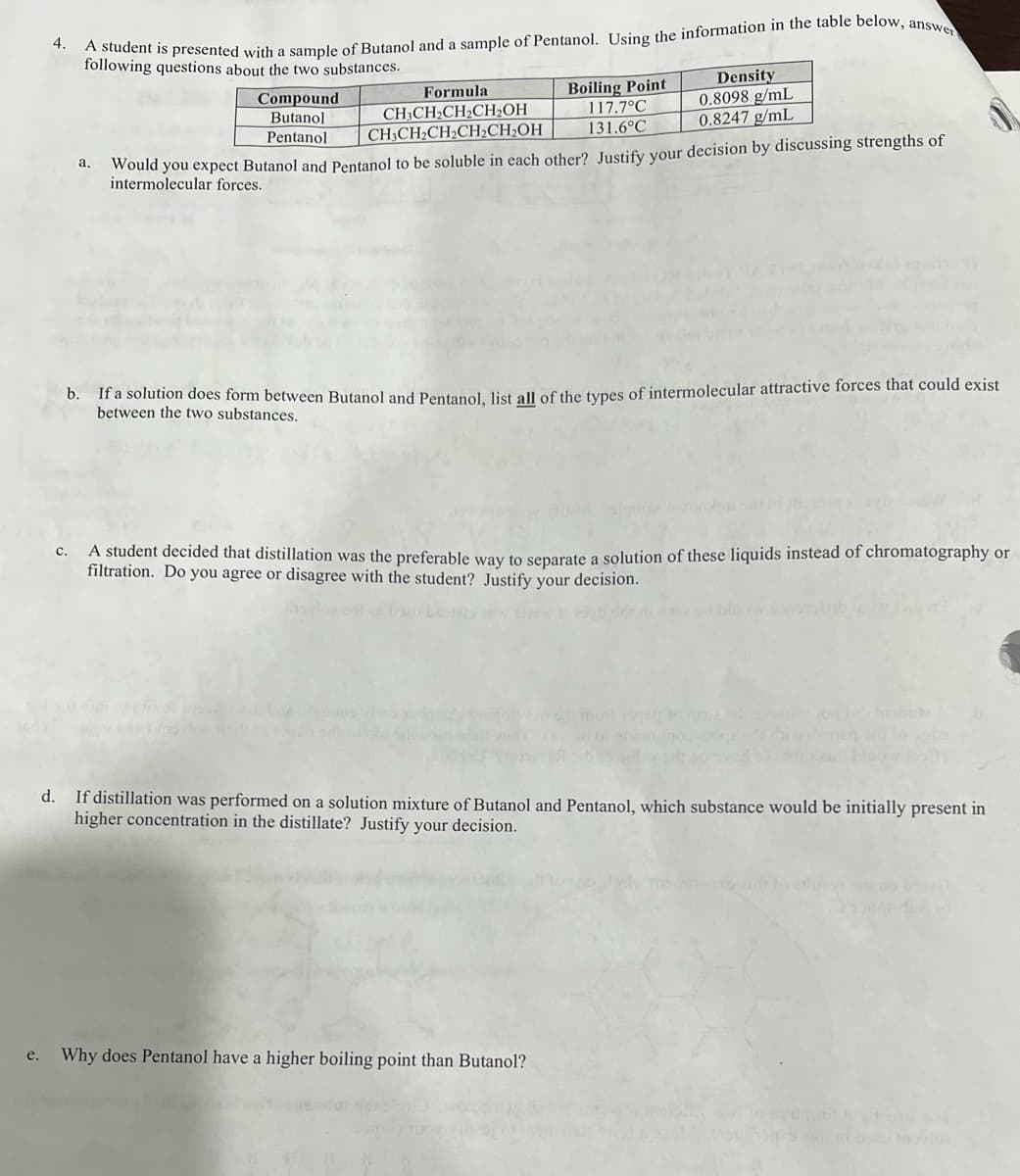d. If distillation was performed on a solution mixture of Butanol and Pentanol, which substance would be initially present in higher concentration in the distillate? Justify your decision.
d. If distillation was performed on a solution mixture of Butanol and Pentanol, which substance would be initially present in higher concentration in the distillate? Justify your decision.
Chapter11: Properties Of Solutions
Section: Chapter Questions
Problem 47E: Rationalize the trend in water solubility for the following simple alcohols: Alcohol Solubility...
Related questions
Question
100%
how would you do 4d? this is a non graded practice worksheet

Transcribed Image Text:4.
A student is presented with a sample of Butanol and a sample of Pentanol. Using the information in the table below, answer
following questions about the two substances.
a.
Compound
Butanol
Pentanol
Formula
CH3CH₂CH₂CH₂OH
CH3CH₂CH₂CH₂CH₂OH
Boiling Point
117.7°C
Density
0.8098 g/mL
0.8247 g/mL
131.6°C
Would you expect Butanol and Pentanol to be soluble in each other? Justify your decision by discussing strengths of
forces.
b.
If a solution does form between Butanol and Pentanol, list all of the types of intermolecular attractive forces that could exist
between the two substances.
C.
A student decided that distillation was the preferable way to separate a solution of these liquids instead of chromatography or
filtration. Do you agree or disagree with the student? Justify your decision.
d. If distillation was performed on a solution mixture of Butanol and Pentanol, which substance would be initially present in
higher concentration in the distillate? Justify your decision.
e. Why does Pentanol have a higher boiling point than Butanol?
Expert Solution
This question has been solved!
Explore an expertly crafted, step-by-step solution for a thorough understanding of key concepts.
Step by step
Solved in 4 steps

Knowledge Booster
Learn more about
Need a deep-dive on the concept behind this application? Look no further. Learn more about this topic, chemistry and related others by exploring similar questions and additional content below.Recommended textbooks for you


Chemistry: An Atoms First Approach
Chemistry
ISBN:
9781305079243
Author:
Steven S. Zumdahl, Susan A. Zumdahl
Publisher:
Cengage Learning

Chemistry
Chemistry
ISBN:
9781305957404
Author:
Steven S. Zumdahl, Susan A. Zumdahl, Donald J. DeCoste
Publisher:
Cengage Learning


Chemistry: An Atoms First Approach
Chemistry
ISBN:
9781305079243
Author:
Steven S. Zumdahl, Susan A. Zumdahl
Publisher:
Cengage Learning

Chemistry
Chemistry
ISBN:
9781305957404
Author:
Steven S. Zumdahl, Susan A. Zumdahl, Donald J. DeCoste
Publisher:
Cengage Learning

Chemistry by OpenStax (2015-05-04)
Chemistry
ISBN:
9781938168390
Author:
Klaus Theopold, Richard H Langley, Paul Flowers, William R. Robinson, Mark Blaser
Publisher:
OpenStax

Chemical Principles in the Laboratory
Chemistry
ISBN:
9781305264434
Author:
Emil Slowinski, Wayne C. Wolsey, Robert Rossi
Publisher:
Brooks Cole

Chemistry for Today: General, Organic, and Bioche…
Chemistry
ISBN:
9781305960060
Author:
Spencer L. Seager, Michael R. Slabaugh, Maren S. Hansen
Publisher:
Cengage Learning